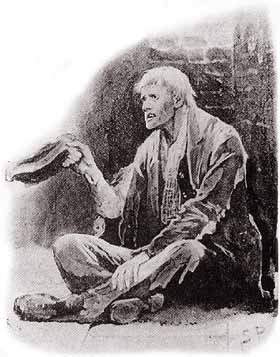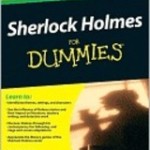A Scion Society of The Baker Street Irregulars

Data! Data! Data! – The Man with the Twisted Lip
“‘Data! Data! Data!‘ he cried impatiently. ‘I can’t make bricks without clay.’”
– The Adventures of The Copper Beeches (COPP)

This column is composed of material (Data!) developed for a short course called Appreciating Sherlock Holmes that I teach twice a year in the Community Education Life Enrichment Program for a local community college. It is composed of “points of information” that are common to many / most / all of the 60 Canonical stories.
The information here has been researched by me or borrowed / stolen from many efforts of other Sherlockians.
COMMENT – Holmes had observed Hugh Boone “at work” on an occasion or two. And he didn’t realize that it was a disguise?
HERE GOES This month’s story The Man with the Twisted Lip…….
CHRISTOPHER MORLEY SAID . . .
“Dr. Watson gallantly left his evening armchair to rescue one of his patients from an opium den in the slums of East London. There he unexpectedly met Sherlock Holmes who was investigating the mysterious disappearance of Mr. Neville St. Clair. The gentleman had apparently been drowned in four and a half feet of water, his pockets weighted down with 691 copper coins.”
 DUMMIES SHORT SUMMARY (From Sherlock Holmes for Dummies by Steven Doyle & David Crowder)
DUMMIES SHORT SUMMARY (From Sherlock Holmes for Dummies by Steven Doyle & David Crowder)
“Holmes uses one of his greatest tools – his pipe – to work out the solution to this case. It’s a real “three pipe problem”!”
PUBLISHING HISTORY
- This is the 8th of the 60 tales published.
- In England it was published in the Strand Magazine in December 1891
- It is part of The Adventures of Sherlock Holmes collection published by George Newnes, Ltd., London, 1892 and, in the U.S. by Harper Bros., New York, in 1892
- The British illustrator was Sidney Paget
HOW MANY WORDS?
According to C. E. Lauderback, 1960 – – found on SHERLOCKIAN.NET, the former website of Chris Redmond, at 9,271 words TWIS has the 41st most words (#1 is VEIL – 4,499, #56 if NAVL – 12,701)
THE BEST OF SHERLOCK HOLMES (How do Sherlockians rate this story?)
- 1927 – It was not on Doyle’s list of 12 favorites but was #16 on his amended list of 19 a few years later
- 1999 – The Baker Street Irregulars voted it 10th best of the 56 short stories
- 1999 – The Sherlock Holmes Society of London voted it 13th best of the 56 short stories
CLASSIFYING THE CASE (From the Wandering Gipsies of Grimpen Mire of Decatur, Alabama)
This case is one of 7 classified as fear of physical harm or public scandal. The others are COPP, CREE, GLOR, SUSS, SCAN, and 3STU.
CHRONOLOGICALLY SPEAKING
Doyle was often very vague about stating WHEN the tale took place and included few contemporary references to help. Whether this was done intentionally or unthinkingly, the dating of events in the Canon is a very popular pastime pursued by several of our “scholars” researching and justifying their results to no end. We will again default to William Baring-Gould’s dating of Saturday, June 18 to Sunday, June 19, 1887. Most Sherlockian “chronologists” actually agree on the dating. This makes this story is 10th of the 60 in elapsed time. This would make Holmes 33 and Watson 35.
WHAT ELSE HAPPENED IN YEAR 1887?
It is always interesting to see what else in happening at the same time as the stories. 1887 was a very busy year in colonial activities, science, art and other areas. The real list is much longer.
- British East Africa Company charter awarded.
- Zululand becomes protectorate.
- Victoria’s Golden Jubilee, end of Windsor Retirement.
- Britain annexes Zululand.
- “People’s Palace” first stage, the Queen’s Hall, opens in East End.
- Irish Coercion Act; Irish Land Act.
- Coal Mines Regulation Act, boys under 13 not to work underground, and under 12 at the surface.
- United States begins free mail delivery to homes of any community with a population of 10,000 or more.
- China recognizes Portugal right to the island of Macao.
- German Reichstag dissolved; alliance of Imperialists, Conservatives, some National Liberals–the Kartel–gave Bismarck majority in the new Reichstag; military grants renewed.
- Renewal of Russo-German ‘Reinsurance’ Treaty; and Triple Alliance.
- France advances Russia 350 million francs.
- Italian force annihilated by Ethiopians at Dogali; designs on Tripoli conditionally supported by Britain and Germany.
- Union of Indo-China formed by France.
- Macao recognized as Portuguese by China.
- Yellow River floods in China, killing nearly a million people.
- S. Interstate Commerce Act, federal control of interstate railways.
- Conan Doyle’s A Study in Scarlet, first Sherlock Holmes story, published.
- Rider Haggard publishes She and Allan Quatermain.
- Emile Zola publishes La Terre, a bitter novel about peasant life.
- L. Zamenhof publishes first book in Esperanto.
- Cazanne paints The Blue Vase.
- Claude A. Debussy debuts Le Printemps.
- Monet paints Fields in Spring.
- Van Gogh paints Le Moulin de la Gallette and Boulevard de Clichy.
- Verdi debuts Othello.
- Radio waves discovered by Hertz.
- Bauxite, source of aluminum, is discovered in Georgia.
- Edison and Swan combine to produce ‘Ediswan’ electric lamps for domestic use.
- Mach defines the Mach Number, now used in supersonic flight.
- Michelson and Morley experiment on the relative velocity of light in perpendicular directions; no speed difference found, results later lead to Einstein’s Theory of Relativity.
- Daimler four-wheeled motor car produced.
- Goodwin invents celluloid film.
- Svante A. Arrhenius proposes ion theory of electrolysis.
- A. von Welsbach demonstrates practical incandescent gas mantle.
- Construction of first British torpedo cruiser.
HOLMES AND WATSON – PERSONAL INFO
Watson is practicing medicine and living with wife, who calls him “James”. Holmes is M rs. Hudson’s lone tenant.
DRAMATIS PERSONAE
This story doesn’t have a big cast but one with “diversity.”
- ELIAS WHITNEY,D., principle of the theological college, St. George.
- ISA WHITNEY, his brother. Addicted to opium.
- KATE WHITNEY, Isa’s wife. College friend of Mrs. Watson.
- NEVILLE ST. CLAIR, the man with the twisted lip.
- HUGH BOONE, alias of Neville.
- ST. CLAIR, Neville’s wife.
- A LASCAR, confidant of St. Clair/Boone.
- INSPECTOR BARTON, in charge of the investigation.
- INSPECTOR BRADSTREET, showed Holmes to Boone’s cell and helped wash his face.
- JOHN, a groom who held Holmes’ horses.
“QUOTABLE SHERLOCK”
All of our quotes are from Holmes to Watson, unless noted.
- “I suppose, Watson, that you imagine that I have added opium-smoking to cocaine injections, and all other little weaknesses on which you have favored me with your medical views.”
- “Oh, a trusty comrade is always of use; and a chronicler still more so.”
- “You have a grand gift of silence, Watson,” said he. “It makes you quite invaluable as a companion.
- Holmes to Neville St. Clair – “It is, of course, a trifle, but there is nothing so important as trifles.”
- “I have seen too much not to know that the impression of a woman may be more valuable than the conclusion of an analytical reasoner.”
- “I reached this one by sitting upon five pillow and consuming an ounce of shag.”
HOLMES’ FEE
There is no mention of a fee. Holmes stayed at client’s house in the country (Lee, in Kent).
SHERLOCK ON THE BIG SCREEN & THE LITTLE SCREEN
The nature of our story makes for a lot of good “visuals” and has been done several times.
- 1921 The Man with the Twisted Lip was the 8th movie with Eille Norwood as Holmes and in one of a small handful restored and available
- 1951 The Man who Disappeared with John Longden as Holmes. It was a pilot British TV Episode for a series that never happened
- 1965 The Man with the Twisted Lip was an episode in the 1-year series with Douglas Wilmer as Holmes and Nigel Stock as Watson
- 1986 The Man with the Twisted Lip was an episode from BBC/Granada staring Jeremy Brett as Holmes and Edward Hartwicke as Watson.
- 2000 The Man with the Twisted Lip was an episode of Sherlock Holmes in the 22nd Century (Animated TV series).
SHERLOCK HOLMES IN DISGUISE
The Master of disguise used the deception of being disguised 14 times in 11 of the 60 stories. Our story features the central character in disguise, but Holmes joins in as an opium smoker disguise.
UNRECORDED CASES (That involved Holmes)
Watson would tease / torture his readers with “I know something you don’t.” Oh my, how Sherlockians love this category. I have in excess of over 150 examples in my collection.
- The rascally Lascar who runs The Bar of Gold in upper Swandam Lane has sworn to have vengeance upon Holmes
FAINTING IN THE CANON (courtesy of Sherlockian Karen Murdock)
Fainting is extremely common in the Canon, appearing, in some form, in 37 of the 60 tales. In 21 cases someone actually faints. In 22 cases someone almost faints. And in 5 cases someone pretends to faint. In this month’s story Mrs. St. Clair faints.
HOLMES’S PUBLISHED & PROJECTED WORKS
Sherlockians love this topic and are regularly searching for these items. Holmes mentions published or projected works in 11 of the stories, but no one even come close in this one.
IS THERE A DOCTOR IN THE HOUSE?
Victorian London, in the Holmes’ time, had approximately 1 doctor for every 100 people. 31 of the 60 tales have a doctor in them. This, of course, does not count Holmes’ Boswell. This listing is by Leslie Klinger in the Winter, 2015 edition of the Baker Street Journal. In this story there was no doctor involved or mentioned.
NEWSPAPERS (Real and Fictional)
Though included in only 20 tales some of our more obsessed Sherlockians love this one. There is no mention of the press by name in this tale.
ANNOTATED SHERLOCK
The 60 Sherlock Holmes stories used English as spoken in England from the 1880’s until the 1910’s. Some words are foreign to us today and need a “contemporary translation.”. For example:
- “James” – Watson’s wife called him “James.” Watson’s middle name was “Hamish” (really?). which is Scottish for “James.” This has led to many, many suppositions by Sherlockians.
- “a slop shop” – A small store selling clothing and other articles to sailors.
- “mousseline-de-soie” – A soft thin silk fabric with a weave like that of muslin.
- “Gravesend” – An ancient busy river port in Kent where vessels on way up the Thames changed their sea pilots for rive pilots. Pocahontas is buried at Gravesend.
- “Gladstone Bag” – A long, light, narrow leather traveling bag opening very wide, name for Britain’s celebrated Prime Minister.
- “laudanum” – an alcoholic preparation of opium in liquid form, commonly administered as a pain reliever in Victorian times.
- “Lascar” – an Anglo-Persian term which formerly meant non-combatant but later came to mean any extra personal on shipboard and, especially, “native” sailors who supplemented the crews on European vessels.
- “a dog-cart” – an open one-horse vehicle with two transverse seats back-to-back, possibly with the rearmost seats made to close to for a box for dogs.
- “a box of bricks” – a box of wooden blocks for a child to build with.
- “wax vestas” -short matches with shanks of thin wax tapers. In ancient Rome, Vesta was goddess of the hearth.
- “octavo size” – printer’s term for page size by folding a printer’s sheet into eight leaves. In contrast “folio” size is the result of folding the printer’s sheet once to make two leaves (4 pages); “quato” is folding the sheet twice, making four leaves (8 pages)
- “dollar” – British slang for the crown, or 5-shilling piece
WEAPONS (from A Compendium of Canonical Weaponry by Dettman and Bedford)
So many things can be considered “weapons” that only 2 or 3 tales fail to have at least one. Since this column is running long, here is a list of “weapons” with no explanation. In spite of the nature of our story there is no real weapon used or implied. The only thing remotely considered by some is:
- Mudbanks – Of the Thames, below Swandam Lane, which were frequently used by the proprietors of The Bar of Gold, an opium den, to rid themselves of unwanted customers, and which was thought by police to have been used by Hugh Boone to dispose of the body of Neville St. Clair.
 Frank Mentzel, aka Merridew of Abominable Memory, when not planning for the Spring 2019 semester of his Appreciating Sherlock Holmes class. After this recent cold spell, he is looking forward to being able to work in his garden once it gets warmer.
Frank Mentzel, aka Merridew of Abominable Memory, when not planning for the Spring 2019 semester of his Appreciating Sherlock Holmes class. After this recent cold spell, he is looking forward to being able to work in his garden once it gets warmer.

Sorry, comments are closed for this post.